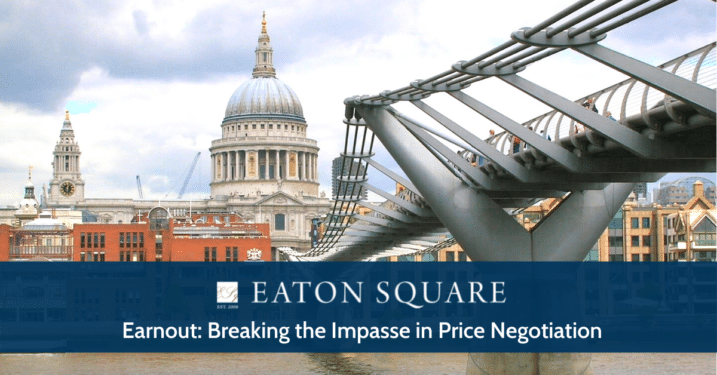
Posted on 5 月 13, 2021 by Jim Afinowich 在 M&A News
A useful tool even in normal times, the earnout concept is growing in popularity as a way to bridge the gap between the amount that a buyer is willing to pay and the seller is willing to accept.
One of the roadblocks that commonly arise in structuring a business sale stems from differing viewpoints of value. Most sellers see maximum profit potential, while most buyers see risk and past earnings. Sellers will typically focus on their company’s recent performance, while buyers will average the company’s performance from previous years. This can make it difficult for the buyer to gain comfort and protection and the seller to achieve the desired profit.
Never has this been more true than now, as the economic impact of COVID-19 and the resulting uncertainty in the market, has tended to widen the “value gap” that separates sellers and buyers.
In the wake of the pandemic, we have seen a small number of deals die, and we do not expect them to be resurrected. Some other deals are moving forward more or less as planned.
In between, we are seeing 50% or more of active deals initially being put on hold – either because the seller wants to wait for their business’s market value to bounce back, or the seller is holding fast to a previously agreed price while the buyer doubts that the business is worth today what it was previously.
Bridging the Gap
When such an impasse occurs, an earnout can bridge the value gap between buyer and seller in a way that provides potentially maximum value to the seller without increasing risk for the buyer. The buyer getting the business now at a lower price, and the seller has a chance to recoup the difference down the road.
By basing the difference in desired price on future performance over a set period of time, earnouts allow the seller to earn the difference out of profits – if the business performs. On the flip side, the buyer is responsible only for paying the difference if the company meets or beats predicted profit margins, thus earning its ultimate value.
Against the backdrop of COVID-19, the buyer’s half of the dialogue might go something like this:
“OK, Mr. Seller, you think your business is worth $50 million. You might be right, but we’re not so sure, considering everything that’s going on. We think that, today, it’s worth $40 million. How about we give you that now, and the other $10 million will be paid out of earnings over the next ‘x’ years if we achieve EBITDA of ‘x’ for the 36 months after we close.”
Whether the seller maintains an active involvement in the company is a point of negotiation. Depending on the circumstances and the relationship between the parties, the seller’s continuing presence (and knowledge, skill, reputation and profit motive) could prove to be a true win-win.
A second way that earnouts can be used is as a safeguard for the buyer. If the acquired business has customer concentration issues, an earnout mechanism can help protect the buyer by tying sales price to client retention. In this way, the buyer is able to balance potential risks and rewards.
A third instance in which an earnout is commonly employed involves the sale of a professional practice. Due to the highly visible role of the seller, buyers acquiring professional practices face added risks upon the seller’s departure. Utilizing an earnout ensures that the buyer pays only for retained customers, patients or clients while simultaneously giving the seller added incentives to pass all relationships on to the buyer. The sale of legal, accounting and medical practices are all examples of professional practices in which seller-client relationships play a major role.
Thoroughness
Since earnouts are based on the company’s future performance, they often work best when the seller remains in control for the duration of the earnout period. This ensures that the seller is responsible for performance numbers in order to satisfy the earnout, while avoiding the potential disagreements and blame that might arise if the earnout fails to meet expectations while under the buyer’s sole management.
(It is important to know that earnouts are different from promissory notes, especially in that, unlike promissory notes, earnouts do not collect interest.)
The language and structure of the earnout should be clearly established when the business is sold. For this reason, it is especially important that both parties’ representatives be familiar with the process and how to best protect their clients. The agreement should specify the following:
- Duration. The typical duration varies from two to five years and often sets a performance average. For example, Year 1 may fall below expectations, but if Year 2 exceeds expectations by a considerable margin the earnout is applied evenly.
- Cap/Floor. Since the earnout depends on the company’s performance, it is advisable that a minimum be set in order to protect the seller, while a maximum is sometimes set to protect the buyer.
- Revenue Basis. In many cases a buyer will try to base the earnout on a percentage of the company’s net profit, and the seller will move to base the earnout on gross sales. In most cases the fairest option is a compromise: gross profit.
- Provisions in Case of Litigation. Sellers should have provisions for security and default similar to those of a promissory note, since earnouts are essentially a type of deferred payment.
Level Playing Field
Because earnouts are based on revenue, it is important that major structural changes do not take place during the earnout time period.
If, for example, the seller stays on for the duration of the earnout and is forced by the new buyer to spend a large portion of the company’s income on R&D, new marketing, or the hiring of new employees, the seller may be shortchanged. This can be avoided by including a provision that requires any major change in expenses to be deducted solely from the buyer’s earnings after calculating the earnout payout.
Earnout Percentage
Due to their flexible nature, earnouts can be used in many ways. The most common use is bridging relatively small price discrepancies between the buyer and seller, but other earnout structures also exist. Though not necessarily advisable in most situations, it is possible to have deal based on a 100% earnout. Very high earnout ratios should be used only when a seller has (a) extreme confidence in the company’s profit potential and (b) a legal team with extensive earnout experience.
A Powerful Tool
An earnout is nothing new; it has long been a powerful and, until recently, underutilized tool that offers the opportunity to expand a deal’s potential and share the risk and reward between buyer and seller.
Looking back, part of the underutilization has stemmed from complexity.
Looking ahead, particularly to complete a deal in uncertain times, parties should recognize the potential benefit as outweighing the complexity. Far from being something that discourages its use, the earnout should be seen for what it is: A powerful enabler allowing both the buyer and seller maximum profitability, productivity, and deal satisfaction.
*This article originally appeared in IBG’s blog.
